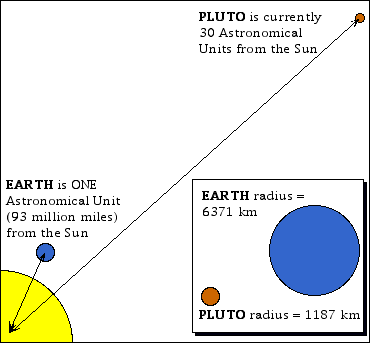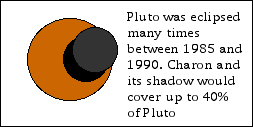

Pluto's angular size is about the same as a quarter that's 25 miles away from you!
Even the Hubble Space Telescope has trouble seeing things that small.
Pluto's moon Charon was discovered in 1976. Charon is about half the diameter of Pluto. Pluto and Charon always show the same face to each other, just as our Moon always shows the same face to us on the Earth. Charon goes around Pluto every 6.32 days.
From 1985 through 1990 Pluto and Charon eclipsed each other every 6.3 days!

Although we could not SEE Charon moving across Pluto's disk, we could watch both objects as a dot in the sky. The dot would get dimmer every time that Charon moved in front of Pluto. By keeping track of what part of Pluto was covered up and how dim the dot became, we could tell how bright the covered-up parts of Pluto must be. After watching many eclipses, we could piece together a mosaic of Pluto's surface (at least the half of Pluto that always faces Charon). If you had recorded eclipses in several colors, you could even make a color map of Pluto.
Credit: Eliot Young, Southwest Research Institute/NASA Planetary Astronomy Program. Copyright 2002 Southwest Research Institute.
This map of Pluto was made from over 22 eclipse observations spanning 1985 to 1990. The brighter areas on Pluto (like the south polar region or the bright spot in the upper right quadrant) are mainly nitrogen frost. Most of Pluto has a red-brown tint, possibly the result of photochemically produced hydrocarbons (think condensed smog!) that are mixed in with the frost.